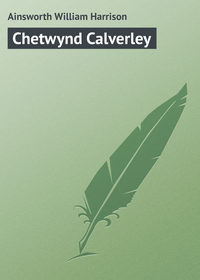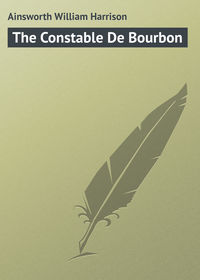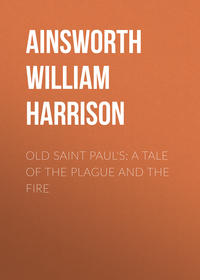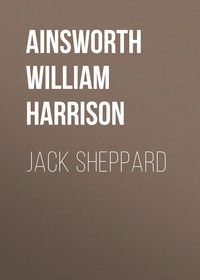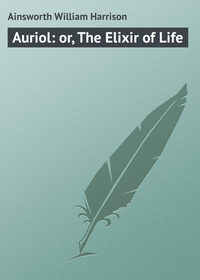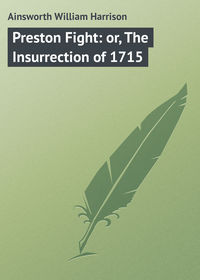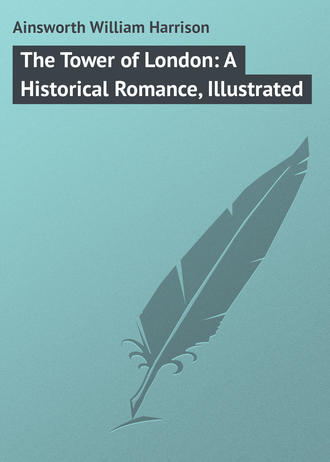 полная версия
полная версияThe Tower of London: A Historical Romance, Illustrated
While this was passing, Cicely hastily threw a surcoat of velvet over her mistress’s shoulders, to protect her from the night air, and then prostrating herself before her, clasped her hand, and bedewed it with tears.
“Rise, child,” said Jane, raising her and embracing her – “Farewell! may you be speedily united to your lover, and may your life be happier than that of your unfortunate mistress!”
“My barge awaits you at the stairs,” observed Lord Clinton.
“We will follow you, my lord,” said Dudley.
Leaning upon Cicely, Jane, who was scarcely able to support herself, was placed in the stern of the boat. Her husband took his seat near her, and two men-at-arms, with drawn swords, were stationed as a guard on either side of them. Bidding a hasty adieu to the weeping Cicely, Cholmondeley sprang into the boat, and was followed by Clinton, who immediately gave the signal to the rowers. Cicely lingered till the bark disappeared, and as two halberdiers bearing torches were placed in the fore part of the vessel, she was enabled to track its course far down the river. When the last glimmer of light vanished, her heart died within her, and she returned to indulge her grief in solitude.
Meanwhile, the boat with its unhappy occupants pursued a rapid course. The tide being in their favour they shortly reached London, and as they swept past Durham House – whence, only twelve days ago, she had proceeded in so much pomp to the Tower – Jane’s feelings became too poignant almost for endurance. The whole pageant rose before her in all its splendour. Again she heard the roar of the cannon announcing her departure. Again she beheld the brilliant crowd of proud nobles, gaily-dressed cavaliers, lovely and high-born dames, grave prelates, judges and ambassadors. Again she beheld the river glistening with golden craft. Again she heard the ominous words of Gunnora, ‘Go not to the Tower!’ Again she beheld the fierce lightning flash, again heard the loud thunder roll – and she felt she had received a deep and awful warning. These thoughts affected her so powerfully, that she sank half fainting on her husband’s shoulder.
In this state she continued till they had shot London Bridge, and the first object upon which her gaze rested, when she opened her eyes, was the Tower.
Here again other harrowing recollections arose. How different was the present, from her former entrance into the fortress! Then a deafening roar of ordnance welcomed her. Then all she passed saluted her as Queen. Then drawbridges were lowered, gates opened, and each vied with the other to show her homage. Then a thousand guards attended her. Then allegiance was sworn – fidelity vowed – but how kept? Now all was changed. She was brought a prisoner to the scene of her former grandeur, unattended, unnoted.
Striving to banish these reflections, which, in spite of her efforts, obtruded themselves upon her, she strained her gaze to discover through the gloom the White Towrer, but could discern nothing but a sombre mass like a thunder-cloud. St. Thomas’s, or Traitor’s Tower was, however, plainly distinguishable, as several armed men carrying flambeaux were stationed on its summit.
The boat was now challenged by the sentinels – merely as a matter of form, for its arrival was expected, – and almost before the answer could be returned by those on board, a wicket, composed of immense beams of wood, was opened, and the boat shot beneath the gloomy arch. Never had Jane experienced a feeling of such horror as now assailed her – and if she had been crossing the fabled Styx she could not have felt greater dread. Her blood seemed congealed within her veins as she gazed around. The lurid light of the torches fell upon the black dismal arch – upon the slimy walls, and upon the yet blacker tide. Nothing was heard but the sullen ripple of the water, for the men had ceased rowing, and the boat impelled by their former efforts soon struck against the steps. The shock recalled Jane to consciousness. Several armed figures bearing torches were now seen to descend the steps. The customary form of delivering the warrant, and receiving an acknowledgement for the bodies of the prisoners being gone through, Lord Clinton, who stood upon the lowest step, requested Jane to disembark. Summoning all her resolution, she arose, and giving her hand to the officer, who stood with a drawn sword beside her, was assisted by him and a warder to land. Lord Clinton received her as she set foot on the step. By his aid she slowly ascended the damp and slippery steps, at the summit of which, two personages were standing, whom she instantly recognised as Renard and De Noailles. The former regarded her with a smile of triumph, and said in a tone of bitter mockery as she passed him – “So – Epiphany is over. The Twelfth Day Queen has played her part.”
“My lord,” said Jane, turning disdainfully from him to Lord Clinton – “will it please you to conduct me to my lodging?”
“What he! warders,” cried Lord Clinton, addressing the gigantic brethren who were standing near – “Conduct Lady Jane Dudley to Master Partridge’s dwelling till her chamber within the Brick Tower is prepared. Lord Guilford Dudley must be taken to the Beauchamp Tower.”
“Are we to be separated?” cried Jane.
“Such are the Queen’s commands,” replied Lord Clinton, in a tone of deep commiseration.
“The Queen’s!” exclaimed Jane.
“Ay! the Queen’s!” repeated Renard. “Queen Mary of England, whom Heaven long preserve!”
THUS FAR THE FIRST BOOK OF THE CHRONICLE OF THE TOWER OF LONDONBOOK THE SECOND
I. – OF THE ARRIVAL OF QUEEN MARY IN LONDON; OF HER ENTRANCE INTO THE TOWER; AND OF HER RECEPTION OF THE PRISONERS ON THE GREEN
MARY made her public entry into the city of London, on the 3d of August, 1553. The most magnificent preparations were made for her arrival, and as the procession of the usurper – for such Jane was now universally termed, – to the Tower, had been remarkable for its pomp and splendour, it was determined, on the present occasion, to surpass it. The Queen’s entrance was arranged to take place at Aldgate, and the streets along which she was to pass were covered with fine gravel from thence to the Tower, and railed on either side. Within the rails stood the crafts of the city, in the dresses of their order; and at certain intervals were stationed the officers of the guard and their attendants, arrayed in velvet and silk, and having great staves in their hands to keep off the crowd.
Hung with rich arras, tapestry, carpets, and, in some instances, with cloths of tissue gold and velvet, the houses presented a gorgeous appearance. Every window was filled with richly-attired dames, while the roofs, walls, gables, and steeples, were crowded with curious spectators. The tower of the old church of Saint Botolph, the ancient walls of the city, westward as far as Bishopgate, and eastward to the Tower postern, were thronged with beholders. Every available position had its occupant. St. Catherine Coleman’s in Fenchurch Street – for it was decided that the royal train was to make a slight detour – Saint Dennis Backchurch; Saint Benedict’s; All Hallows, Lombard Street; in short, every church, as well as every other structure, was covered.
The Queen, who had passed the previous night at Bow, set forth at noon, and in less than an hour afterwards, loud acclamations, and still louder discharges of ordnance, announced her approach. The day was as magnificent as the spectacle – the sky was deep and cloudless, and the sun shone upon countless hosts of bright and happy faces. At the bars without Aldgate, on the Whitechapel road, Queen Mary was met by the Princess Elizabeth, accompanied by a large cavalcade of knights and dames. An affectionate greeting passed between the royal sisters, who had not met since the death of Edward, and the usurpation of Jane, by which both their claims to the throne had been set aside. But it was noted by those who closely observed them, that Mary’s manner grew more grave as Elizabeth rode by her side. The Queen was mounted upon a beautiful milk-white palfrey, caparisoned in crimson velvet, fringed with golden thread. She was habited in a robe of violet-coloured velvet, furred with powdered ermine, and wore upon her head a caul of cloth of tinsel set with pearls, and above this a massive circlet of gold covered with gems of inestimable value. Though a contrary opinion is generally entertained, Mary was not without some pretension to beauty. Her figure was short and slight, but well proportioned; her complexion rosy and delicate; and her eyes bright and piercing, though, perhaps, too stern in their expression. Her mouth was small, with thin compressed lips, which gave an austere and morose character to an otherwise-pleasing face. If she had not the commanding port of her father, Henry the Eighth, nor the proud beauty of her mother, Catherine of Arragon, she inherited sufficient majesty and grace from them to well fit her for her lofty station.
No one has suffered more from misrepresentation than this queen. Not only have her failings been exaggerated, and ill qualities, which she did not possess, attributed to her, but the virtues that undoubtedly belonged to her, have been denied her. A portrait, perhaps too flatteringly coloured, has been left of her by Michele, but still it is nearer the truth than the darker presentations with which we are more familiar. “As to the more important qualities of her mind, with a few trifling exceptions, (in which, to speak the truth, she is like other women, since besides being hasty and somewhat resentful, she is rather more parsimonious and miserly than is fitting a munificent and liberal sovereign,) she has in other respects no notable imperfection, and in some things she is without equal; for not only she is endowed with a spirit beyond other women who are naturally timid, but is so courageous and resolute that no adversity nor danger ever caused her to betray symptoms of pusillanimity. On the contrary, she has ever preserved a greatness of mind and dignity that is admirable, knowing as well what is due to the rank she holds as the wisest of her councillors, so that in her conduct and proceedings during the whole of her life, it cannot be denied she has always proved herself to be the offspring of a truly royal stock. Of her humility, piety, and observance of religious duties, it is unnecessary to speak, since they are well known, and have been proved by sufferings little short of martyrdom; so that we may truly say of her with the Cardinal, that amidst the darkness and obscurity which overshadowed this kingdom, she remained like a faint flame strongly agitated by winds which strove to extinguish it, but always kept alive by her innocence and true faith, in order that she might one day shine to the world, as she now does.” Other equally strong testimonies to her piety and virtue might be adduced. By Camden she is termed a “lady never sufficiently to be praised for her sanctity, charity, and liberality.” And by Bishop Godwin – “a woman truly pious, benign, and of most chaste manners, and to be lauded, if you do not regard her failure in religion.” It was this “failure in religion” which has darkened her in the eyes of her Protestant posterity. With so many good qualities it is to be lamented that they were overshadowed by bigotry.
If Mary did not possess the profound learning of Lady Jane Grey, she possessed more than ordinary mental acquirements. A perfect mistress of Latin, French, Spanish and Italian, she conversed in the latter language with fluency. She had extraordinary powers of eloquence when roused by any great emotion, and having a clear logical understanding, was well fitted for argument. Her courage was undaunted; and she possessed much of the firmness of character – obstinacy it might perhaps be termed, of her father. In the graceful accomplishment of the dance, she excelled, and was passionately fond of music, playing with skill on three instruments, the virginals, the regals, and the lute. She was fond of equestrian exercise, and would often indulge in the chace. She revived all the old sports and games which had been banished as savouring of mummery by the votaries of the reformed faith. One of her sins in their eyes was a fondness for rich apparel. In the previous reign female attire was remarkable for its simplicity. She introduced costly stuffs, sumptuous dresses, and French fashions.
In personal attractions the Princess Elizabeth far surpassed her sister. She was then in the bloom of youth, and though she could scarcely be termed positively beautiful, she had a very striking appearance, being tall, portly, with bright blue eyes, and exquisitely formed hands, which she took great pains to display.
As soon as Elizabeth had taken her place behind the Queen, the procession set forward. The first part of the cavalcade consisted of gentlemen clad in doublets of blue velvet, with sleeves of orange and red, mounted on chargers trapped with close housings of blue sarsenet powdered with white crosses. After them rode esquires and knights, according to their degree, two and two, well mounted, and richly apparelled in cloth of gold, silver, or embroidered velvet, “fresh and goodlie to behold.” Then came the trumpeters, with silken pennons fluttering from their clarions, who did their devoir gallantly. Then a litter covered with cloth of gold, drawn by richly-caparisoned horses, and filled by sumptuously-apparelled dames. Then an immense retinue of nobles, knights, and gentlemen, with their attendants, all dressed in velvets, satins, taffeties, and damask of all colours, and of every device and fashion – there being no lack of cloths of tissue, gold, silver, embroidery, or goldsmith’s work. Then came forty high-born damsels mounted on steeds, trapped with red velvet, arrayed in gowns and kirtles of the same material. Then followed two other litters covered with red satin. Then came the Queen’s body guard of archers, clothed in scarlet, bound with black velvet, bearing on their doublets a rose woven in gold, under which was an imperial crown. Then came the judges; then the doctors; then the bishops; then the council; and, lastly, the knights of the Bath in their robes.
Before the Queen rode six lords, bare-headed, four of whom carried golden maces. Foremost amongst these rode the Earls of Pembroke and Arundel, bearing the arms and crown. They were clothed in robes of tissue, embroidered with roses of fine gold, and each was girt with a baldrick of massive gold. Their steeds were trapped in burnt silver, drawn over with cords of green silk and gold, the edges of their apparel being fretted with gold and damask. The Queen’s attire has been already described. She was attended by six lacqueys habited in vests of gold, and by a female attendant in a grotesque attire, whom she retained as her jester, and who was known among her household by the designation of Jane the Fool. The Princess Elizabeth followed, after whom came a numerous guard of archers and arquebussiers. The retinue was closed by the train of the ambassadors, Noailles and Renard. A loud discharge of ordnance announced the Queen’s arrival at Aldgate. This was immediately answered by the Tower guns, and a tremendous and deafening shout rent the air. Mary appeared greatly affected by this exhibition of joy, and as she passed under the ancient gate which brought her into the city, and beheld the multitudes assembled to receive her, and heard their shouts of welcome, she was for a moment overcome by her feelings. But she speedily recovered herself, and acknowledged the stunning cries with a graceful inclination of her person.
Upon a stage on the left, immediately within the gate, stood a large assemblage of children, attired like wealthy merchants, one of whom – who represented the famous Whittington – pronounced an oration to the Queen, to which she vouchsafed a gracious reply. Before this stage was drawn up a little phalanx, called the “Nine children of honour.” These youths were clothed in velvet, powdered with flowers-de-luce, and were mounted on great coursers, each of which had embroidered on its housing a scutcheon of the Queen’s title – as of England, France, Gascony, Guienne, Normandy, Anjou, Cornwall, Wales and Ireland. As soon as the oration was ended, the Lord Mayor, Aldermen, Sheriffs, and their officers and attendants, rode forth to welcome the Queen to the city. The Lord Mayor was clothed in a gown of crimson velvet, decorated with the collar of SS., and carried the mace. He took his place before the Earl of Arundel, and after some little delay the cavalcade was again set in motion. First marched the different civic crafts, with bands of minstrelsy and banners; then the children who had descended from the stage; then the nine youths of honour; then the city guard; and then the Queen’s cavalcade as before described.
Mary was everywhere received with the loudest demonstrations of joy. Prayers, wishes, welcomings, and vociferations attended her progress. Nothing was heard but “God save your highness – God send you a long and happy reign.” To these cries, whenever she could make herself heard, the Queen rejoined, “God save you, all my people. I thank you with all my heart.” Gorgeous pageants were prepared at every corner. The conduits ran wine. The crosses and standards in the city wore newly painted and burnished. The bells pealed, and loud-voiced cannon roared. Triumphal arches covered with flowers, and adorned with banners, targets, and rich stuffs, crossed the streets. Largesse was showered among the crowd with a liberal hand, and it was evident that Mary’s advent was hailed on all hands as the harbinger of prosperity. The train proceeded along Fenchurch Street, where was a “marvellous cunning’ pageant, representing the fountain of Helicon, made by the merchants of the Stillyard; the fountain ran abundantly-racked Rhenish wine till night.” At the corner of Gracechurch Street there was another pageant, raised to a great height, on the summit of which were four pictures; above these stood an angel robed in green, with a trumpet to its mouth, which was sounded at the Queen’s approach, to the “great marvelling of many ignorant persons.” Here she was harangued by the Recorder; after which the Chamberlain presented her with a purse of cloth of gold, containing a thousand marks. The purse she graciously received, but the money she distributed among the assemblage. At the corner of Gracechurch Street another stage was erected. It was filled with the loveliest damsels that could be found, with their hair loosened and floating over their shoulders, and carrying large branches of white wax. This was by far the prettiest spectacle she had witnessed, and elicited Mary’s particular approbation. Her attention, however, was immediately afterwards attracted to the adjoining stage, which was filled with Romish priests in rich copes, with crosses and censers of silver, which they waved as the Queen approached, while an aged prelate advanced to pronounce a solemn benediction upon her. Mary immediately dismounted, and received it on her knees. This action was witnessed with some dislike by the multitude, and but few shouts were raised as she again mounted her palfrey. But it was soon forgotten, and the same cheers that had hitherto attended her accompanied her to the Tower. Traversing East-cheap, which presented fresh crowds, and offered fresh pageants to her view, she entered Tower Street, where she was welcomed by larger throngs than before, and with greater enthusiasm than ever. In this way she reached Tower Hill, where a magnificent spectacle burst upon her.
The vast area of Tower Hill was filled with spectators. The crowds who had witnessed her entrance into the city had now flocked thither, and every avenue had poured in its thousands, till there was not a square inch of ground unoccupied. Many were pushed into the moat, and it required the utmost exertion of the guards, who were drawn out in lines of two deep, to keep the road which had been railed and barred from the end of Tower Street to the gates of the fortress clear for the Queen. As Mary’s eye ranged over this sea of heads – as she listened to their stunning vociferations, and to the loud roar of the cannon which broke from every battlement in the Tower, her heart swelled with exultation. It was an animating spectacle. The day, it has been said, was bright and beautiful. The sun poured down its rays upon the ancient fortress, which had so lately opened its gates to an usurper, but which now like a heartless rake had cast off one mistress to take another. The whole line of ramparts on the west was filled with armed men. On the summit of the White Tower floated her standard, while bombard and culverin kept up a continual roar from every lesser tower.
After gazing for a few moments in the direction of the lofty citadel, now enveloped in the clouds of smoke issuing from the ordnance, and, excepting its four tall turrets and its standard, entirely hidden from view, her eyes followed the immense cavalcade, which, like a swollen current, was pouring its glittering tide beneath the arch of the Bulwark Gate; and as troop after troop disappeared, and she gradually approached the fortress, she thought she had never beheld a sight so grand and inspiriting. Flourishes of trumpets, almost lost in the stunning acclamations of the multitude, and the thunder of artillery, greeted her arrival at the Tower. Her entrance was conducted with much ceremony. Proceeding through closely-serried ranks of archers and arquebussiers, she passed beneath the Middle Gate and across the bridge. At the By-ward Tower she was received by Lord Clinton and a train of nobles. On either side of the gate, stood Gog and Magog. Both giants made a profound obesiance as she passed. A few steps further, her course was checked by. Og and Xit. Prostrating himself before her, the elder giant assisted his diminutive companion to clamber upon his back, and as soon as he had gained this position, the dwarf knelt down, and offered the keys of the fortress to the Queen. Mary was much diverted at the incident, nor was she less surprised at the vast size of Og and his brethren – than at the resemblance they presented to her royal father. Guessing what was passing through her mind, and regardless of consequences as of decorum, Xit remarked, —
“Your majesty, I perceive, is struck with the likeness of my worthy friend Og to your late sire King Henry VIII., of high and renowned memory. You will not, therefore, be surprised, when I inform you that he is his – ”
Before another word could be uttered, Og, who had been greatly alarmed at the preamble, arose with such suddenness, that Xit was precipitated to the ground.
“Pardon me, your majesty,” cried the giant, in great confusion, “it is true what the accursed imp says. I have the honour to be indirectly related to your highness. God’s death, sirrah, I have half a mind to set my foot upon thee and crush thee. Thou art ever in mischief.”
The look and gesture, which accompanied this exclamation, were so indescribably like their royal parent, that neither the Queen nor the Princess Elizabeth could forbear laughing.
As to Xit, the occurrence gained him a new friend in the person of Jane the Fool, who ran up as he was limping off with a crestfallen look, and begged her majesty’s permission to take charge of him. This was granted, and the dwarf proceeded with the royal cortege. On learning the name of his protectress, Xit observed, —
“You are wrongfully designated, sweetheart. Jane the Queen was Jane the Fool – you are Jane the Wise.”
While this was passing, Mary had given some instructions in an under tone to Lord Clinton, and he immediately departed to fulfil them. The cavalcade next passed beneath the arch of the Bloody Tower, and the whole retinue drew up on the Green. A wide circle was formed round the queen, amid which, at intervals, might be seen the towering figures of the giants, and next to the elder of them, Xit, who having been obliged to quit his new friend had returned to Og and was standing on his tip-toes to obtain a peep at what was passing. No sooner had Mary taken up her position, than Lord Clinton re-appeared, and brought with him several illustrious persons who having suffered imprisonment in the fortress, for their zeal for the religion of Rome, wore now liberated by her command. As the first of the group, a venerable nobleman, Approached her and bent the knee before her, Mary’s eyes filled with tears, and she exclaimed, in a voice of much emotion, —
“Arise, my Lord Duke of Norfolk. The attainder pronounced against you in my father’s reign is reversed. Your rank, your dignities, honours, and estates shall be restored to you.”



